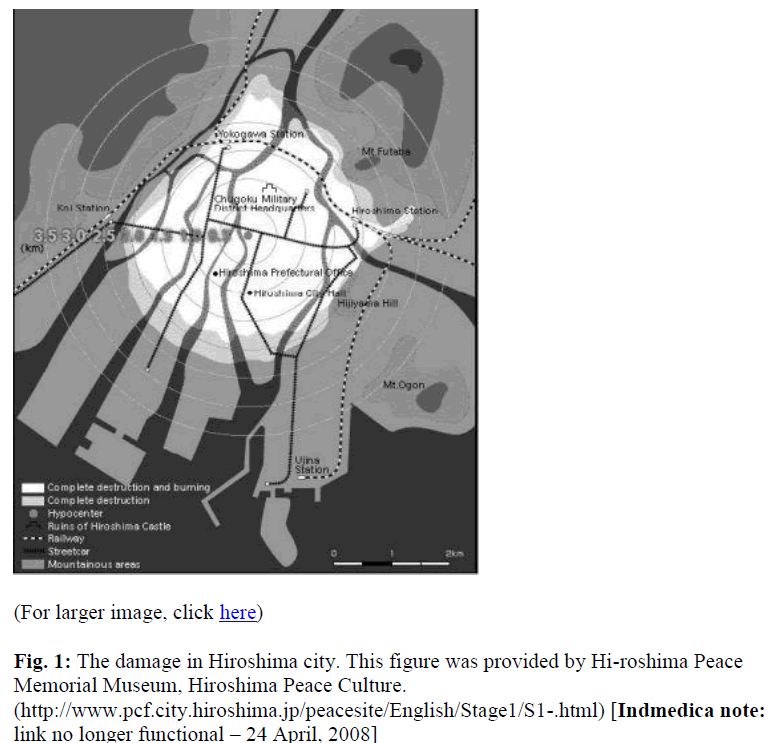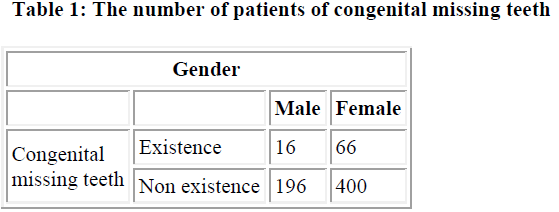ISSN: 0970-938X (Print) | 0976-1683 (Electronic)
Biomedical Research
An International Journal of Medical Sciences
- Biomedical Research (2006) Volume 17, Issue 1
Prevalence of congenital missing teeth in the offspring of Hiroshima atomic bomb survivors
Department of Orthodontics and Craniofacial Developmental Biology, Graduate School of Biomedical Sciences, Hiroshima University, 1-2-3 Kasumi, Minami-ku, Hiroshima 734-8553, Japan
- *Corresponding Author:
- Kawata Toshitsugu
Department of Orthodontics and Craniofacial Developmental Biology
Graduate School of Biomedical Sciences, Hiroshima University
1-2-3 Kasumi Minami-ku, Hiroshima 734-8553, Japan
Phone: +81-82-257-5686
Fax: +81-82-257-5687
E-mail: tenzan ( at ) hiroshima-u.ac.jp
Accepted date: December 14, 2005
A number of studies have been conducted on atomic bomb (A-bomb) survivors in Hi-roshima and Nagasaki, evaluating the late influence of ionizing radiation on humans. The enormous atomic bomb explosion caused massive destruction and loss of lives in Hiroshima in 1945. The present study was conducted to examine the relationship between radiation exposure and prevalence of congenital missing teeth. Six hundred seventy-eight orthodontic patients (212 males, 466 females), had registered in our clinic. Questionnaires were used to the enrollers for the examination. Generally, the number of female patients with congenital missing teeth were greater than that of males. In our study, the number of patients with congenital missing teeth was found to be significantly higher in the radiation exposed affected families compared to that of non-affected ones. In these radiation exposed families, male subjects also exhibited higher prevalence of congenital missing teeth than the females of the non-affected families. These findings suggest that the higher rate of missing teeth in the offspring of Hiroshima atomic bomb survivors is possibly the consequence of the exposure of ionic radiation.
Keywords
Hiroshima atomic bomb survivors, questionnaire, congenital missing teeth, social environment
Introduction
The enormous atomic bomb explosion caused massive destruction and loss of lives in Hiroshima in 1945. De-struction was instantaneous. In addition to tremendous social and economic losses, the health of survivors was subject to continuing damage due to aftereffects of burns and radiation. The complex effects compounded by other losses created by numerous obstacles that impaired patient(s) recovery of physical and economic well-being. Approximately 140,000 people were dead (±10,000) as of the end of December 1945 (Hiroshima’s estimated population was 350,000). The A-bomb exploded close to the center of the city, and because 85% of the city buildings were within 3 km of the explosion site, physical destruction of the city was nearly complete, with 90% of buildings collapsed or burned. (August 1946 Survey by the Hiroshima City Government) [Fig. 1 Damage due to Heat Radiation]. Radiation had caused various problems over the decades that followed, such as higher rates of leukemia, peaking after contamination [1,2]. The incidence of malignant tumors such as thyroid, breast, lung and salivary-gland neoplasm, began to increase in the 1960 [3,4] Furthermore, the report of the malformation in the craniofacial by radiation was carried out [5]. The present study was conducted to examine the relationship between radiation exposure and prevalence of congenital missing teeth.
Patients and Methods
The subjects of this study were patients who visited the Hiroshima University Dentistry Hospital in the past three years. The present study was conducted to examine the relationship between radiation exposure and prevalence of congenital missing teeth. Six hundred seventy-eight orthodontic patients (212 males, 466 females) registered in our clinic were covered as the subjects. Questionnaires were enrolled. All subjects gave informed consent. The results were compared statistically by χ2-test.
Results
It seems that the atomic bomb dropped in Hiroshima in-fluenced broadly the area as shown in Fig 1.The survey showed that 82 subjects have congenital missing teeth among the total of 678 (2.1%).The male and female rates were 14.2% and 7.5%, respectively. Tendency of higher rates of congenital missing teeth in females had previ-ously been recorded. However, our finding is consistent with the previous reports. Congenital missing teeth are more common in descendants of A-bomb victims than others (P<0.05) (Table. 2).
Figure 1: The damage in Hiroshima city. This figure was provided by Hi-roshima Peace Memorial Museum, Hiroshima Peace Culture.
(http://www.pcf.city.hiroshima.jp/peacesite/English/Stage1/S1-.html) [Indmedica note: link no longer functional – 24 April, 2008]
Discussion
The rates in previous studies with congenital missing teeth were 7.9% [6], 9.2% [7], 9.91% [8], 10.9% [9], and 14.9% [10], respectively. Research of Hanaoka and Ya-mano [10] was conducted at the Hiroshima University Dentistry Hospital. It seems that Hiroshima University has many patients without congenital missing teeth. Gene mutation by radiation was proven by Muller [11] and in recent years, genes related to dental genesis has been discovered in experimental animals. MSX1 and PAX9 were discovered as dental formation genes [12-14]. Further-more, MSX1 is related to the 2nd premolar and 3rd molar [12]. PAX9 is related to congenital missing molars [13,14]. Many A-bomb victims’ sequelae cannot be attributed to radiation, however, it seems that missing teeth is likely a resultant condition related to radiation exposure [7]. In the future, patient’s detailed gene analysis will be investigated.
Acknowledgements
We appreciate the cooperation of Mr. Tsuboi Sunao, who is a member of the representation committee of Japan Confederation of Atomic and Hydrogen-Bomb Sufferers Organizations. This work was supported in part by a grant from the Hiroshima University.
References
- Aker GS, Hoel DG. Corrections in the atomic bomb data to examine low dose risk. Health Phys. 2003; 85: 709-720.
- Harada H, Harada Y, Tanaka H, et al. Implications of somatic mutations in the AML1 gene in radiation-associated and therapy-related myelodysplastic syndrome/acute myeloid leukemia. Blood. 2003; 101: 673-680.
- Izumi S, Koyama K, Soda M, et al. Cancer incidence in children and young adults did not increase relative to parental exposure to atomic bombs. Br J Cancer. 2003; 89: 1709-1713.
- Yamada M, Wong FL, Fujiwara S, et al. Noncancer disease incidence in atomic bomb survivors, 1958-1998. Radiat Res 2004; 161: 622-632.
- Akimoto N, Ikeda T, Satow Y, et al. Craniofacial and oral malformations in an autopsy population of Japanese human fetuses and newborns. J Craniofac Genet Dev Biol 1986; 2: 213-233.
- Kawashima S. The relationship between anomales in number of teeth and malocclusion. J Jan Orthod Soc 1936; 5: 1-12 (in Japanese).
- Hanaoka H, Yamauchi K, Kawasoko S, et al. Anomales in number of teeth of orthodontic patients. Relatio-ship to malocclusion. J Jan Orthod Soc 1972; 31: 162-167 (in Japanese).
- Yamada H, Ogawa K, Le L, et al. A survey of hypodontia in orthodontic patients. J Aichi-Gakuin Univ Dent Soc 2000; 38: 249-255 (in Japanese).
- Watanabe K, Mototoshi M, Fumui R, et al. A study on incidence of congenital missing of teeth among orthodontic patients. Nihon Univ Dent J 1992; 66: 1029- 1033 (in Japanese).
- Yamano C, Yamauchi K, Kawasoko S, et al. Anomalies in number of teeth of orthodontic patients I. Supernumerary teeth 1969; 1: 50-53.
- Muller HJ. Artificial transmission of the gene. Science. 1927; 66: 84.
- Chen Y, Bei M, Woo I, et al. Msx1 controls inductive signaling in mammalian tooth morphogenesis. Development. 1996; 122: 3035-3044.
- Das P, Stockton DW, Bauer C, et al. Haploinsufficiency of PAX9 is associated with autosomal dominant hypodontia. Hum Genet. 2002; 110: 371-376.
- Frazier-Bowers SA, Guo DC, Cavender A, et al. A novel mutation in human PAX9 causes molar oligodontia. J Dent Res. 2002; 81: 129-133.


